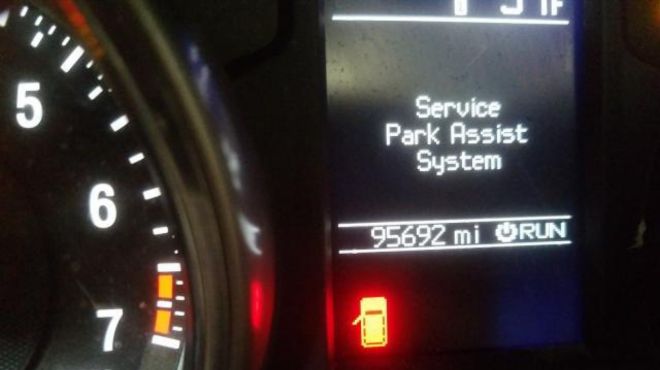Park assist system uses sensors and cameras mounted around the bumpers to detect objects near your vehicle. As you get close to obstacles, it alerts you so you can avoid collisions.
This system can malfunction and suddenly flash up a “Service Park Assist System” error message to your Jeep dashboard. This message indicates a problem with the system’s operation. Potential causes can include dirty or damaged sensors, electrical issues, problems with related systems like brakes or steering, or malfunctioning controller modules.

In most cases, you can get the system working properly again on your own without rushing off to the dealership. This handy guide will walk through how to troubleshoot and fix common issues triggering the dreaded service message. With a few simple tools and tips, you’ll have your Jeep’s parking super powers back in no time.
What Causes the Service Park Assist System Error Message?
Dirty or Faulty Sensors
The sensors are the most important part of how the park assist system works. They provide key information to the system about the vehicle’s surroundings and position relative to other objects.
The Jeep uses a combination of radar sensors and proximity sensors mounted around the bumpers. If the signal coming from those sensors is incorrect or missing, it will trigger the “service park assist system” error message.
There are several potential causes of dirty or faulty sensors:
- The sensors could just be really dirty from normal road grime. Snow, ice buildup, dead bugs, and other debris on the sensors can interfere with their operation. Even leftover dirt or residue from washing the car can affect them. Regular cleaning is essential.
- Driving through water, mud, or snow can allow moisture and condensation to get inside the sensor housings over time, leading to shorts and functionality issues.
- Physical damage is another possibility. The sensors are delicate, so even minor bumps or scrapes can damage them. You may not see visible damage, but the sensors can malfunction. Replacing damaged sensors is recommended.
- Adding large aftermarket fenders, bumper accessories, or trailers can sometimes obstruct the sensor’s field of view. The system may disengage if blocked like this.
The bottom line is the sensors are vulnerable to contamination and damage, both of which can make the park assist system think something is wrong. Checking and cleaning the sensors should be the first step in diagnosing the issue.
Also see – Service 4WD Light on Your Jeep: How to Fix?
Check for Issues in Related Systems to Park Assist
The park assist system doesn’t operate in isolation – it interacts with various other components in the vehicle. Problems in those related systems can also be the culprit behind a malfunctioning parking aid.
For example, the park assist relies on working brake and steering systems to function properly. If there are faults in the brakes or steering, it can confuse the parking sensors.
Issues like sticking brakes, worn brake pads, loose steering components, or power steering failure can impact the readings from the wheel speed sensors and other data the park assist depends on. If the system detects inconsistent inputs from those systems, it may trigger the dreaded “service” message.
So don’t ignore any warning lights related to steering, brakes, or suspension. Get those other problems checked out as they could be linked to the parking sensor malfunction. For example, worn out brake pads will need to be replaced. Tightening loose steering parts can get the wheels properly aligned again.
Dealing with issues in interconnected systems is an important step in making sure your park assist feature is ready when you need it. Consider having a certified Jeep mechanic inspect things like brakes and steering if you suspect problems there.
Check Electrical Connections
Like most modern vehicle systems, the park assist relies on electrical components functioning properly. Loose wiring, bad connections, or electrical faults can cause erratic operation.
Some things to inspect in the electrical system:
- Fuses – Over time, vibration can loosen fuses related to the park assist system. Check the fuse box and make sure the appropriate fuses are secure and not blown. Refer to the owner’s manual if unsure which fuse powers the parking sensors.
- Wiring harnesses and connectors – With vibration and exposure to elements, the wiring to the sensors and control module can become loose or corroded. Carefully inspect connections for any detached, frayed or corroded wires. Clean contacts and reconnect any loose plugs firmly.
- Battery – Weak battery voltage can impact electronic systems. Load test the battery to confirm it is providing steady, reliable power to the park assist components.
- Grounds – Inadequate grounding points can interfere with signal transmission. Ensure ground wires are securely attached to clean metal surfaces.
- Aftermarket accessories – Adding electrical devices like lights, winches, radios etc. can sometimes overburden the vehicle’s electrical system. Make sure added devices are properly fused and wired without overloading circuits.
Doing some basic electrical system checks like these can often uncover loose connections or damaged wires causing the park assist trouble. Taking time to check and correct electrical issues now will help get your system functioning reliably.
Faulty Park Assist Module
The brains of the park assist system is the control module. It takes in data from the sensors and processes it to provide alerts and guide the vehicle. If this module is damaged or malfunctioning, it can certainly cause service warnings.
The control module is generally located under the rear left seat in Jeeps. Physical damage from an accident or water intrusion from leaks can corrupt the module’s circuits. Shorts or broken connections on the module can happen over time as well.
If no other issues are found, the module itself may need to be replaced. When installing a new module, it may need calibration or programming by a dealer or mechanic to sync properly with the vehicle. Instructions vary by model year, so consult a repair manual.
Replacing a failed module is more costly than other repairs, but it may be necessary. With an integrated circuit board, the modules are not repairable. To restore full functionality of the park assist feature, a damaged module will need to be switched out.
Check the Electronic Shift Module (ESM)
In addition to the main control module, some Jeep models also use a separate electronic shift module to manage the transmission. Issues with this shift module can impact the park assist when the vehicle is in reverse gear.
The shift module determines what gear the transmission is in based on input from the gear selector. If the shift module malfunctions, it may incorrectly tell the park assist system the vehicle is in reverse when it’s not, or vice versa. This confuses the parking sensors.
Problems to look for in the shift module:
- Corrosion on the connectors – Clean and check for continuity.
- Damaged or detached wiring – Inspect wires and reconnect.
- Faulty sensors on the gear selector – Ensure proper resistance values.
- Bad circuit board – Replace module if faulty.
Start by inspecting the shift module connector pins and wires. Try cleaning the contacts gently with electrical contact cleaner. If no wiring faults are found, the module itself may need to be replaced. Work with a technician who can confirm the module is the issue and reset the transmission programming.
Troubleshooting Tips to Get Park Assist Working Again
If you see the dreaded “Service Park Assist System” message, there are some DIY steps you can try before heading to the shop. Here are tips to get your Jeep’s parking sensors back up and running.
1. Clean All Sensors Thoroughly
As discussed earlier, dirty or blocked sensors are the most common cause of issues. Give the sensors a good cleaning:
- Use a soft cloth, mild soap and warm water. Avoid abrasive cleaners or materials.
- Gently wipe each sensor on the bumpers and any camera lenses.
- Be careful not to apply too much pressure or scratch the sensors.
- Rinse and dry completely. Don’t leave any residue.
- Check for and remove any stuck on debris or foreign objects.
- Inspect sensors and replace any that are damaged or cracked.
Regularly cleaning the sensors helps prevent build up of grime. But even if they don’t appear dirty, give them a quick cleaning to rule out any contamination issues. Just removing stuck on mud or ice can get them working again in some cases.
2. Check the Electrical System
Refer to the earlier section on electrical issues for guidance on things to inspect:
- Load test the battery and charge or replace if low.
- Verify related fuses are not blown, and replace any that are.
- Inspect wiring harnesses and connectors for corrosion, damage, or looseness. Clean and reconnect any problem wires.
- Check ground connections are tight and free of dirt or rust.
- Scan for fault codes that may point to bad components.
Addressing any electrical gremlins in the system can often resolve problems.
3. Reset the Park Assist System
Once any detected electrical or sensor issues are corrected, try resetting the system:
- Turn ignition to “On” but do not start engine.
- Press and hold the ParkSense button on the console for 10-15 seconds until you hear a beep.
- This resets the system’s memory and calibration.
- Turn ignition off and back on to restart the system.
Resetting gives the system a fresh start to redetect obstacles and function normally. Try this after any repairs to see if it clears the service message.
4. Check or Replace the Control Module
If you’ve addressed all other issues but the service message persists, the main control module may be malfunctioning. Here’s how to check it:
- Locate the module, typically under the rear left seat.
- Unplug the connections and check for corrosion or damage.
- Plug back in firmly and test operation.
- If the issue continues, the module likely needs replacement.
- Install a new module and have programmed by a technician.
Faulty modules must be replaced. Make sure to get the correct replacement part for your Jeep model and year. Proper module programming is key to syncing it to the rest of the system.
5. Inspect and Replace the Electronic Shift Module
Similarly, troubleshoot the electronic shift module:
- Check connectors for corrosion and clean electronic shift module if needed.
- Verify wiring continuity and integrity.
- Confirm proper sensor resistance values.
- If module is determined to be bad, replace it.
- May require recalibration by a technician when swapped.
Taking time to confirm and replace a failed shift module can get your park assist working smoothly in reverse again.
Don’t Delay – Fix it Today!
Getting the park assist system back online provides some great benefits:
- Avoids accidents, scrapes and damage when parking in tight spaces. Those sensors help you avoid obstructions you might not see yourself.
- Restores the audible alerts and visual guides that make parking easier. The beeps and camera views are so helpful for safely maneuvering.
- Returns functionality of a feature you paid for. It works as intended when operating properly.
- Can often be a cheap fix by just cleaning dirty sensors. Don’t pay big repair bills unnecessarily.
In many cases, DIY troubleshooting and cleaning can get the system running like normal again. Don’t put it off!
Keep Your Parking Superpower
The park assist system is really convenient for avoiding curb rash and fender benders during tricky parking situations. But like any advanced technology, it can suffer glitches.
When the dreaded “Service Park Assist System” message appears suddenly, don’t panic. In most cases, you can get it working properly again with some basic troubleshooting and sensor cleaning.
By addressing the issue promptly, you can get back your parking superpower and reverse safely again. Maintaining this useful system provides peace of mind every time you pull into a tight spot.
Also Read:



